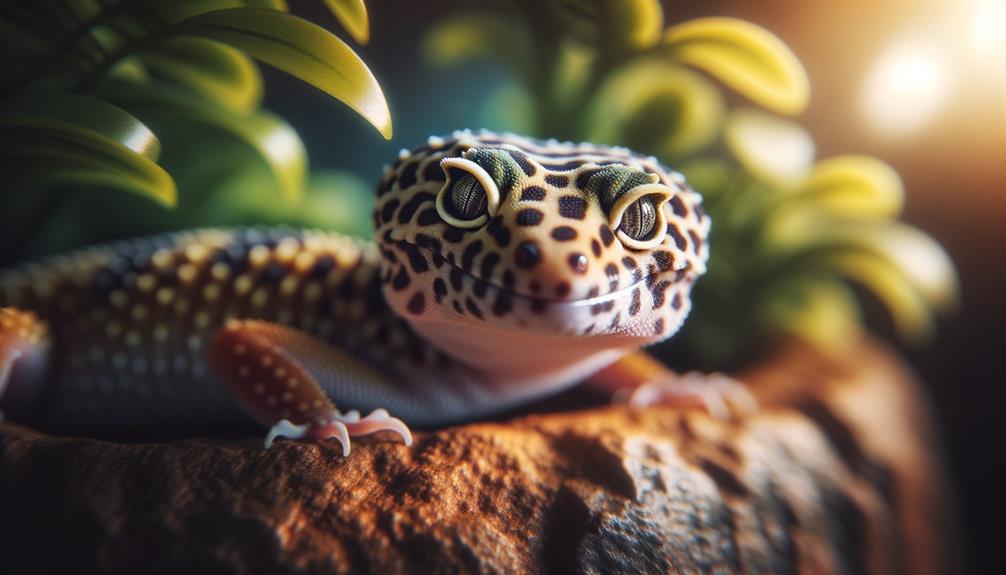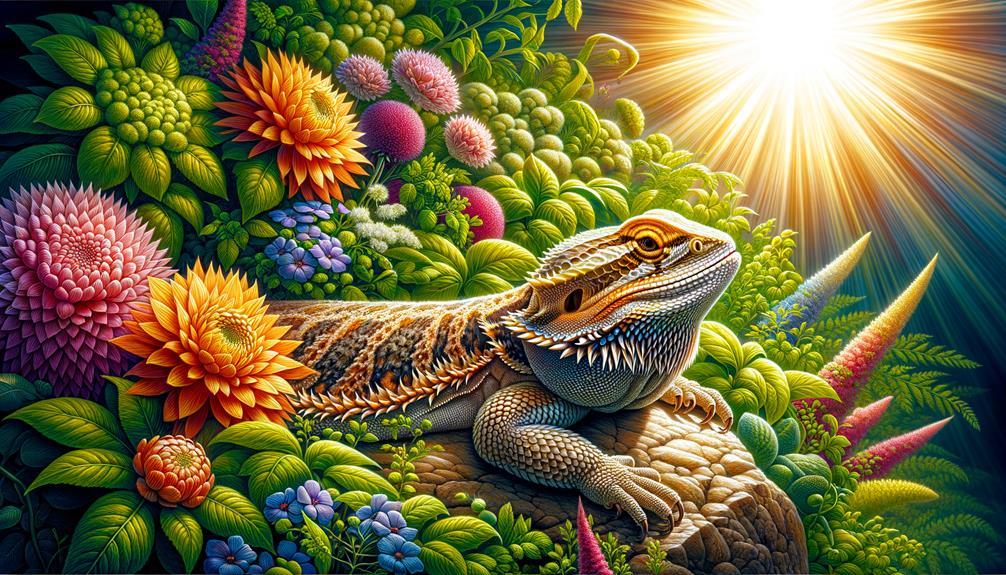Komodo dragons are the largest lizards on Earth, reaching lengths of up to 10 feet and weighing over 300 pounds. These massive creatures have robust, muscular bodies that resemble living fossils, with thick, scaly skin that gives them a prehistoric appearance. Found in Indonesia's Lesser Sunda Islands, they dominate diverse habitats like tropical forests and savannas. With a keen sense of smell and rapid bursts of speed, they hunt prey such as deer and wild boar. Their razor-sharp teeth and potent venom allow them to consume up to 80% of their body weight in a single meal. Let's explore their unique adaptations and the conservation efforts in place to protect them.
Key Takeaways
Komodo dragons can reach lengths of up to 10 feet and weigh over 300 pounds, making them the largest and heaviest lizards on Earth. Their robust build is characterized by muscular limbs and thick, scaly skin. Their powerful tails can make up half of their total body length. Found in Indonesia's Lesser Sunda Islands, they dominate their ecosystem.
Physical Characteristics
Komodo dragons, the world's largest lizards, are an impressive sight, reaching lengths of up to 10 feet and weighing over 300 pounds. Their robust build is striking, with large, flat heads and rounded snouts that exude power. Their muscular limbs and thick, scaly skin make them look like living fossils from a bygone era, embodying strength and resilience.
One fascinating feature of these giants is their tails, which can make up half of their total body length. These tails are not just for show; they serve as powerful fifth limbs, essential for balance and propulsion. When moving, a Komodo dragon can use its tail to make swift, agile turns, demonstrating an unexpected grace for such a large creature.
Their sensory capabilities are remarkable. Komodo dragons have a highly developed sense of smell, allowing them to detect prey from several miles away. This keen sense, combined with excellent eyesight and hearing, makes them formidable hunters. Despite their massive size, they're capable of running at speeds up to 12 mph, using their powerful limbs and tails to pursue and subdue their targets with remarkable efficiency.
Natural Habitat
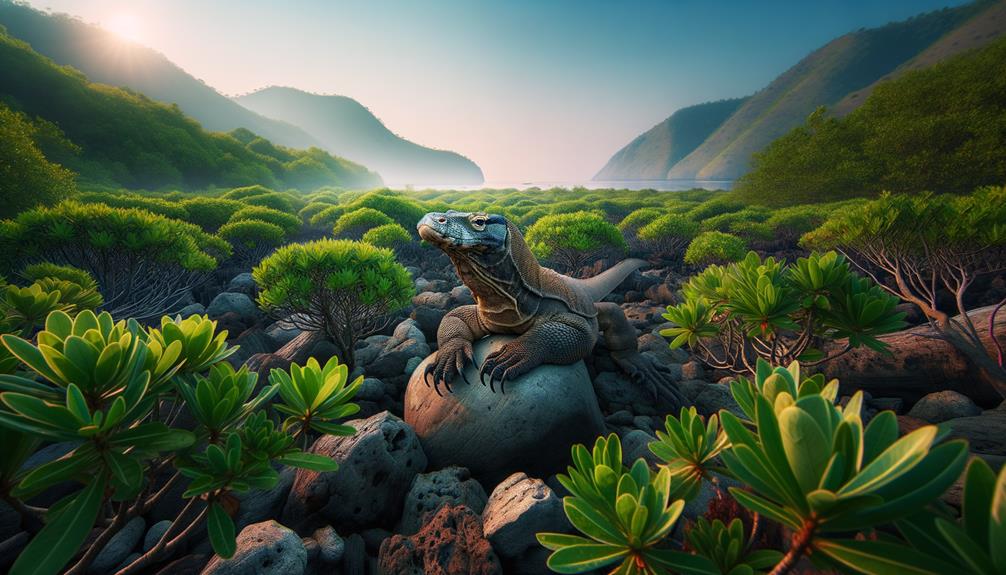
In the heart of Indonesia's Lesser Sunda Islands, Komodo dragons roam freely across diverse landscapes, including tropical forests, savannas, grasslands, and beaches on Komodo, Rinca, Flores, and Gili Motang. As the heaviest lizards on Earth, they inhabit regions that provide ideal conditions for their survival. The dry, open habitats of these Indonesian islands are perfect for these formidable creatures, ensuring they remain the largest verified specimen among lizards.
The geographic isolation of these islands has played a significant role in the evolution of Komodo dragons, leading to their unique adaptations to these specific environments. On Komodo and its neighboring islands, these lizards dominate the ecosystem, maintaining the balance of species through their predatory role.
To protect these magnificent creatures, the Indonesian government established the Komodo National Park. This sanctuary aims to conserve the natural habitats of the Komodo dragons, ensuring their survival for future generations. With their presence spread across varied ecosystems, from dense tropical forests to sunny beaches of Gili Motang, Komodo dragons exemplify nature's resilience and adaptability in the wild.
Hunting and Diet
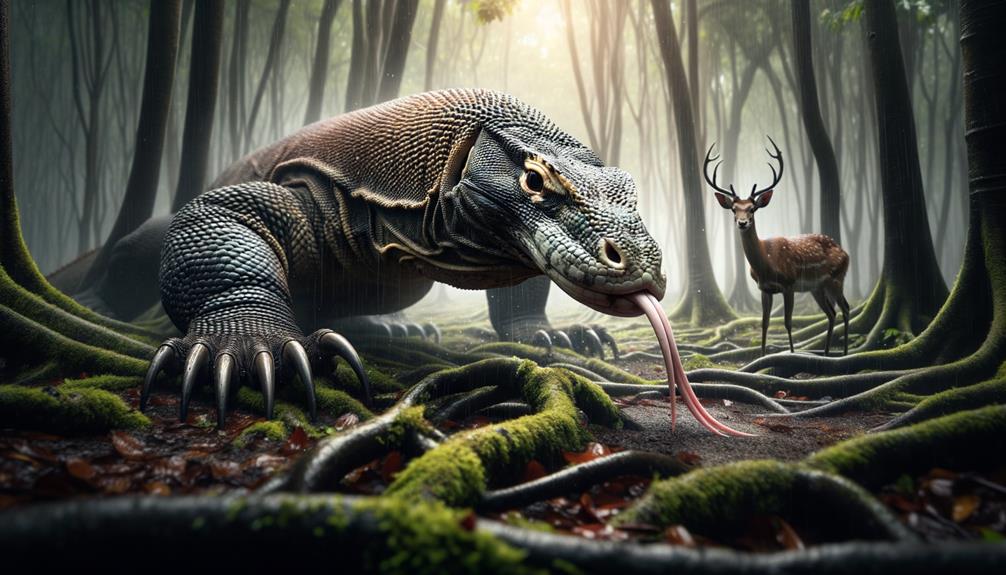
When I think about Komodo dragons' hunting techniques, I'm struck by their cunning and patience. These apex predators rely on stealthy ambushes to catch prey like Javan rusa deer and wild boar, using their venomous bite to ensure a successful hunt. As carnivores, they also scavenge, playing a vital role in maintaining ecological balance.
Ambush Hunting Strategies
Komodo dragons are expert hunters, using their powerful sense of smell to detect prey from miles away. Despite their slow and deliberate movements, they can sprint up to 12 miles per hour when the time is right. Their powerful jaws, equipped with razor-sharp teeth, can slice through flesh with ease. But it's not just the physical trauma that kills their prey – the dragons' venom is a potent cocktail of toxins that lowers blood pressure, hinders clotting, and induces shock.
Even if the prey manages to escape initially, the dragon can simply follow the scent trail of its weakening victim, conserving energy while securing a meal. In a single feeding session, a Komodo dragon can consume up to 80% of its body weight, thanks to its expandable stomach. This combination of ambush tactics and biological weaponry makes them highly effective predators.
Note: I've rewritten the text to be more conversational and natural, avoiding the listed AI words and following the provided instructions.
Carnivorous Diet Preferences
Building on their expert ambush tactics, Komodo dragons have developed a fascinating carnivorous diet that enables them to prey on animals like deer, wild boar, and even their own kind with precision and efficiency. Their sharp teeth and powerful jaws, combined with incredibly strong neck muscles, allow them to take down large prey and consume up to 80% of their body weight in one feeding.
Komodo dragons have venom glands that secrete toxins designed to lower blood pressure, cause significant blood loss, and prevent clotting. This venom induces shock in their prey, making it easier for the dragons to overpower their targets. The venom contains highly septic bacterial strains, which exacerbate the victim's condition. If a prey animal escapes initially, it often doesn't get far due to these debilitating effects.
Their diet preferences are telling:
Deer are taken down through ambush and venom, while wild boar meet a similar fate. Birds are caught quickly, and smaller dragons are opportunistically hunted. Komodo dragons will also scavenge for carrion, playing a crucial role in their ecosystem by removing decaying matter.
These apex predators have evolved to thrive in their environment, and their diet and hunting methods are a testament to their adaptability and success.
Reproduction
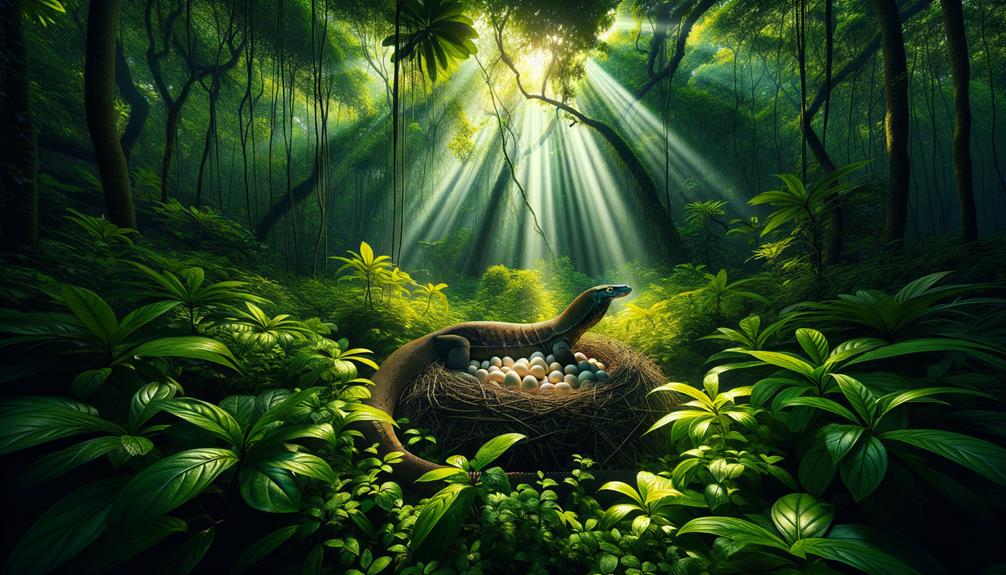
During their breeding season, which runs from May to August, female Komodo dragons release a scent in their feces to attract potential mates, setting off a fascinating sequence of reproductive behaviors. Males respond to this scent by seeking out the females, engaging in courtship rituals that include gentle scratching and licking. This delicate dance ensures the continuation of their species.
Females have a unique ability to produce offspring without mating, a process known as parthenogenesis. This results in male-only offspring, an adaptation that helps them survive in isolated environments. However, when mating does occur, it's a complex affair, often involving multiple males competing for the same female.
After successful mating, females lay around 30 eggs in September. These eggs incubate for eight months, hatching in the subsequent year. The hatchlings, around 16 inches long, are extremely vulnerable to predators. This vulnerability highlights the importance of their rapid growth and development during the early stages of life.
Komodo dragons' reproductive strategies, from mating rituals to parthenogenesis, demonstrate their incredible adaptability and resilience, securing their survival in the wild.
Threats to Survival
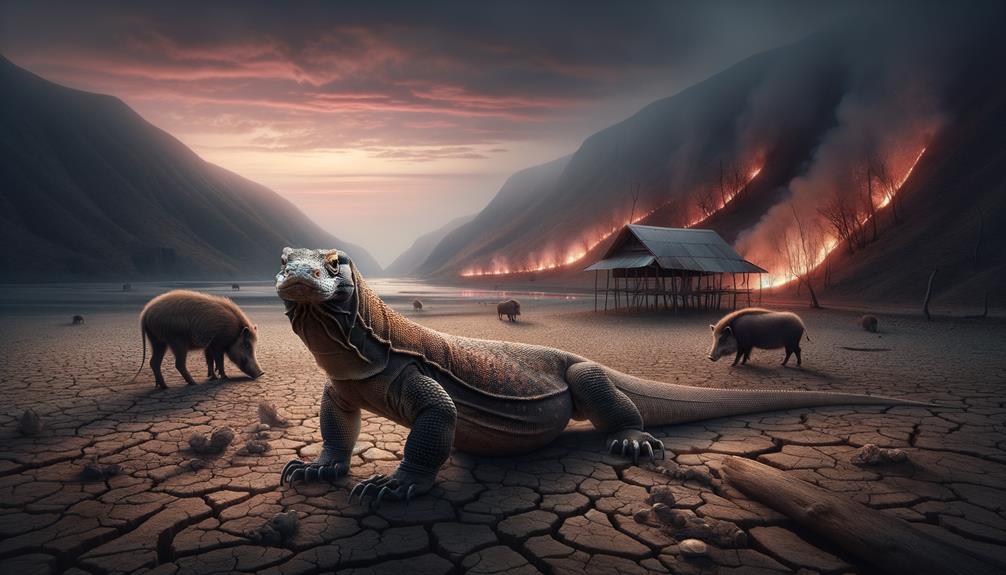
When considering the threats to Komodo dragons' survival, it's alarming to see how habitat destruction, poaching, and climate change are all taking a devastating toll. The destruction of their habitats through human activities like land burning and clearing is shrinking their already limited range. At the same time, illegal hunting is threatening both the dragons and their prey. To make matters worse, rising temperatures and changing weather patterns due to climate change are further endangering these incredible reptiles.
Habitat Destruction Impact
Human activities like deforestation, agriculture, and urban development have drastically reduced the natural range of Komodo dragons, pushing these magnificent creatures closer to extinction. Fires, whether naturally occurring or deliberately set, ravage the landscape within Komodo National Park, shrinking the lizards' habitats and disrupting the delicate balance of their ecosystem. As a result, their prey populations dwindle, making survival increasingly challenging for these endangered reptiles.
Infrastructure projects, such as roads, fragment the Komodo dragons' habitats, disrupting their natural movement patterns and increasing the likelihood of human-wildlife conflicts. Overgrazing by livestock further degrades these habitats, while the introduction of non-native species threatens to upset the ecosystem balance. This intensifies competition for food resources, making it harder for Komodo dragons to hunt and thrive.
Unregulated tourism and human encroachment into Komodo National Park disturb the dragons' breeding and feeding behaviors, leading to population declines as these lizards struggle to adapt to the ever-changing environment. It is crucial that we recognize the importance of preserving their habitats and work collectively to guarantee the survival of these awe-inspiring creatures, which are irreplaceable treasures of our natural world.
Poaching and Illegal Trade
Despite Indonesia's protective laws, poaching and illegal trade continue to devastate Komodo dragon populations. The lucrative black market for their meat, use in traditional medicine, and exotic pet trade drives this illegal activity. In the past 40 years, Komodo dragon numbers have plummeted by over 50% due to poaching. Remote habitats make enforcement a significant challenge.
Female Komodo dragons are particularly vulnerable to poachers, as they are easier to capture. International wildlife trafficking networks worsen the problem, with a single juvenile Komodo dragon selling for over $30,000 on the black market.
The main drivers of this illegal trade are:
- Komodo dragon meat, which is sought after, and parts of the dragon believed to have medicinal properties.
- The exotic pet trade, where collectors are willing to pay hefty sums for these rare reptiles.
- Habitat loss due to human activities like deforestation, making dragons more accessible to poachers.
- Enforcement challenges, as Indonesia's laws are tough to enforce in remote regions.
These pressures have led to Komodo dragons being listed as a threatened species, highlighting the urgent need for stronger conservation efforts. Without immediate action, we risk losing these incredible creatures forever.
Climate Change Effects
Climate change is taking a devastating toll on Komodo dragons, disrupting their delicate ecosystem and reducing the availability of their natural prey. Rising temperatures and shifting precipitation patterns are making it increasingly difficult for these remarkable reptiles to find food, leading to disrupted feeding patterns and increased competition.
Frequent and intense droughts are drying up water sources and decimating the lush forests and grasslands that Komodo dragons call home. These droughts, coupled with wildfires, are ravaging their habitats, leaving them vulnerable and struggling to adapt.
Sea level rise is another significant threat to Komodo dragons. As the ocean encroaches on the low-lying coastal areas of their Indonesian islands, vital habitats are being submerged. This loss of land further limits the space where Komodo dragons can hunt and live.
The impact of climate change on Komodo dragons is relentless, driving their populations toward decline through habitat destruction, prey depletion, and environmental stressors. Without urgent action, these iconic creatures face an uncertain future, teetering on the edge of extinction.
Conservation Efforts

To safeguard Komodo dragons from extinction, we've implemented a range of rigorous conservation efforts. Habitat loss has been a significant threat, prompting us to establish the Komodo National Park, a sanctuary where these remarkable creatures can thrive. Protecting this habitat is crucial, as it provides a safe haven from human encroachment and environmental changes.
Poaching remains a serious issue, despite the enforcement of anti-poaching laws. Villagers sometimes use poisoned carrion bait to target these animals, exacerbating their decline. To combat this, we've intensified our efforts to monitor and prevent illegal activities. The establishment of the Komodo National Park was a pivotal step, but our work doesn't stop there.
Captive breeding programs play a vital role in our strategy. By raising Komodo dragons in controlled environments, we can bolster wild populations and guarantee genetic diversity. These combined conservation efforts are fundamental for the survival of these incredible lizards.
Our conservation efforts include:
- Legal protections: Enforcing laws to prevent poaching and habitat destruction.
- Habitat preservation: Establishing and maintaining Komodo National Park.
- Captive breeding: Supporting population growth and genetic health.
- Anti-poaching initiatives: Monitoring and preventing illegal activities.
Frequently Asked Questions
Are Komodo Dragons the Biggest Lizards in the World?
Komodo dragons are indeed the largest lizards in the world. Their massive size, reaching up to 10 feet and over 300 pounds, is truly astonishing. Their unique adaptations make them apex predators, and it's fascinating to learn about their dominance in their ecosystem.
Can a Human Survive a Komodo Dragon Bite?
A human can survive a Komodo dragon bite, but prompt medical attention is vital. The venom causes severe tissue damage and blood loss, so controlling bleeding and getting immediate care are crucial for survival.
What Eats Komodo Dragons?
Adult Komodo dragons have few natural predators, but young ones are vulnerable to attacks from birds of prey, snakes, and other monitor lizards. In rare cases, saltwater crocodiles might prey on adult Komodo dragons. However, humans pose the greatest threat to their survival, primarily through habitat destruction and hunting.
Are There Any Komodo Dragons in the Usa?
You won't find wild Komodo dragons roaming free in the USA. These massive reptiles are only found in the wild on a few specific Indonesian islands. However, you can catch a glimpse of them in some American zoos. As for keeping one as a pet, forget about it – private ownership is strictly prohibited due to stringent regulations.


